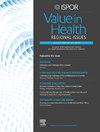Toward Better Measurement of Financial Risk Protection in Health Expenditure: The Case of Chile
IF 1.4
Q3 HEALTH CARE SCIENCES & SERVICES
引用次数: 0
Abstract
Objectives
Our study highlights the impact of out-of-pocket health expenditure (OOPHE) in highly unequal countries, where the middle class is particularly vulnerable to declines in well-being. We modify 2 financial protection measures—impoverishment and catastrophic health expenditure (CHE)—to address this issue. The first adjustment improves the classification of households based on their risk of poverty due to OOPHE, whereas the second corrects the underestimation of CHE for poorer households and the overestimation for the richest.
Methods
We applied our adjusted financial protection measures to data from the Chilean Household Budget Surveys (2006-2007, 2011-2012, 2016-2017, and 2021-2022) and compared the results with conventional CHE and impoverishment measures. Logistic regressions were used to identify factors associated with CHE.
Results
Our impoverishment risk indicator indicates that approximately 10% of Chilean households entered poverty, became poorer, or were at high risk due to OOPHE in 20. Our revised CHE measure suggests that approximately 15.8% of households faced financial hardship, with both figures exceeding conventional estimates. Households with more women and an older average age were more likely to experience CHE.
Conclusions
Effective and equitable access to health services, along with adequate financial protection, is critical to achieving universal health coverage. However, in countries with high-income inequality and a high proportion of nonpoor households close to the poverty line, conventional measures may have blind spots for monitoring and analyzing financial hardship in health spending. This research provides evidence to open the debate on this issue.
更好地衡量卫生支出中的财务风险保护:以智利为例
我们的研究强调了自费医疗支出(OOPHE)在高度不平等国家的影响,在这些国家,中产阶级特别容易受到幸福感下降的影响。为了解决这一问题,我们修改了两项财务保护措施——贫困和灾难性卫生支出(CHE)。第一个调整改进了基于家庭因OOPHE而贫困风险的家庭分类,而第二个调整纠正了对较贫困家庭的低估计和对最富裕家庭的高估计。方法我们将调整后的财务保护措施应用于智利家庭预算调查(2006-2007年、2011-2012年、2016-2017年和2021-2022年)的数据,并将结果与传统的CHE和贫困化措施进行比较。使用逻辑回归来确定与CHE相关的因素。结果我们的贫困风险指标表明,在2010年,大约10%的智利家庭因OOPHE而进入贫困、变得更穷或处于高风险中。我们修订后的CHE指标表明,大约15.8%的家庭面临经济困难,这两个数字都超出了传统的估计。女性较多且平均年龄较大的家庭更有可能经历CHE。结论:有效和公平地获得卫生服务,以及充分的财政保护,对于实现全民健康覆盖至关重要。然而,在高收入不平等和有很大比例的非贫困家庭接近贫困线的国家,传统措施在监测和分析卫生支出的财务困难方面可能存在盲点。这项研究为这个问题的讨论提供了证据。
本文章由计算机程序翻译,如有差异,请以英文原文为准。
求助全文
约1分钟内获得全文
求助全文
来源期刊

Value in health regional issues
Pharmacology, Toxicology and Pharmaceutics-Pharmacology, Toxicology and Pharmaceutics (miscellaneous)
CiteScore
2.60
自引率
5.00%
发文量
127
 求助内容:
求助内容: 应助结果提醒方式:
应助结果提醒方式:


